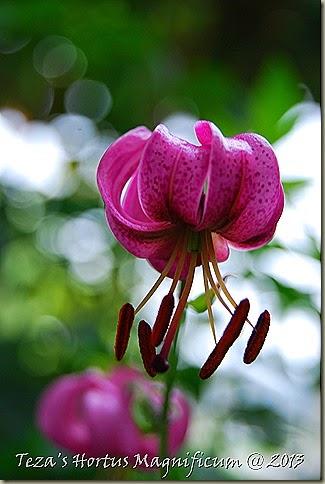15 Jul 2015
Blue I Wonder
When the genus Deinanthe first crossed my radar some eight years ago, I was only aware of there being two species within the genus: Deinanthe bifida, a Japanese herbaceous clumping perennial with white Hydrangea like flowers [appropriate since the two genera are related to one another!] and distinctively notched tips to its foliage [hence bifida] and Deinanthe caerulea, which as its name suggests has lilac to blue suffused flowers, surrounding an exquisite boss of shimmering silver stamens. And which one did I bring home? Both of course!
Skip ahead four or so years, and while perusing the annual Lost Horizons catalogue I discovered a third! Whilst belonging to the species D.caerulea, it was named 'Blue Wonder.' Goodness me, how could I have overlooked something that so obviously spoke to my obsession with the colour blue! Did I really need another excuse to visit with Larry at his woodland plant emporium? I think not!
He confided to me that he wasn't convinced that this was indeed a new cultivar within the species, opting instead that some overzealous gardener had likely added the tag 'Blue Wonder' after noticing a difference in bloom colour from the original species. Regardless, it was an opportunity to add yet a third of this sublime genus - one which I might add, should be far more popular in woodland garden repertoires, but that is just my humble opinion.
The first five photographs in this post are of my 'Blue Wonder', and when comparing it against the final three photos, there are indeed a number of noticeable differences. More excited about their flower characteristics, I did not think to capture the distinctively different foliages - D.caerulea has a coarse, leathery leaf, whereas 'Blue Wonder' is more akin to D.bifida, a bright green, distinctively veined with that decidedly notched end to its foliage. Already I am wondering if in fact this is not D.bifida exhibiting the same character that its cousin, the ubiquitous garden Hydrangea is notorious for: if the soil is acidic enough, the blooms will indeed turn mauve - albeit blue if the acidity level remains high throughout its bloom period. Another noticeable difference is the fact that the stamens of this usurper are in fact white, in sharp contrast to the mesmerizing shimmering effect that D.caerulea exhibits from the moment it opens!
I love witnessing the wonders of Mother Nature, and which ever species this plant belongs to, it has definitely won my heart over. It is a very undemanding perennial, and unlike its cousin the Hydrangea, it is completely herbaceous, dying back to the ground every winter. There is no guess work as to whether it blooms on new or old wood, or whether it will bloom every year - [unlike so many of the so called 'Endless Summer' duds!] it has returned for me year after year, growing in size every year, and has demonstratively proven itself to be hardy to -40C! What is there not to love about this charmer.
The photos below are of D.caerulea. There are many similarities in the overall shape of the flower, but as mentioned earlier, the foliage is markedly different, as are the stamens. I myself prefer the shimmering silver patina that the true species affords. Both have a very fond and special place in this gardener's heart. If you have an opportunity to add any within this genus to your woodland garden, trust me, you will not ever have a moment's regret!
Subscribe to:
Post Comments (Atom)









































No comments:
Post a Comment